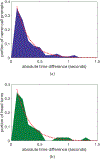Computer Vision Analysis for Quantification of Autism Risk Behaviors
- PMID: 35401938
- PMCID: PMC8993160
- DOI: 10.1109/taffc.2018.2868196
Computer Vision Analysis for Quantification of Autism Risk Behaviors
Abstract
Observational behavior analysis plays a key role for the discovery and evaluation of risk markers for many neurodevelopmental disorders. Research on autism spectrum disorder (ASD) suggests that behavioral risk markers can be observed at 12 months of age or earlier, with diagnosis possible at 18 months. To date, these studies and evaluations involving observational analysis tend to rely heavily on clinical practitioners and specialists who have undergone intensive training to be able to reliably administer carefully designed behavioural-eliciting tasks, code the resulting behaviors, and interpret such behaviors. These methods are therefore extremely expensive, time-intensive, and are not easily scalable for large population or longitudinal observational analysis. We developed a self-contained, closed-loop, mobile application with movie stimuli designed to engage the child's attention and elicit specific behavioral and social responses, which are recorded with a mobile device camera and then analyzed via computer vision algorithms. Here, in addition to presenting this paradigm, we validate the system to measure engagement, name-call responses, and emotional responses of toddlers with and without ASD who were presented with the application. Additionally, we show examples of how the proposed framework can further risk marker research with fine-grained quantification of behaviors. The results suggest these objective and automatic methods can be considered to aid behavioral analysis, and can be suited for objective automatic analysis for future studies.
Keywords: Computer vision; autism; behavior coding; behavior elicitation; mobile-health.
Figures







Similar articles
-
A scalable computational approach to assessing response to name in toddlers with autism.J Child Psychol Psychiatry. 2021 Sep;62(9):1120-1131. doi: 10.1111/jcpp.13381. Epub 2021 Feb 28. J Child Psychol Psychiatry. 2021. PMID: 33641216 Free PMC article.
-
A Scalable Off-the-Shelf Framework for Measuring Patterns of Attention in Young Children and its Application in Autism Spectrum Disorder.IEEE Trans Affect Comput. 2021 Jul-Sep;12(3):722-731. doi: 10.1109/taffc.2018.2890610. Epub 2019 Jan 1. IEEE Trans Affect Comput. 2021. PMID: 35450132 Free PMC article.
-
Computer vision tools for low-cost and noninvasive measurement of autism-related behaviors in infants.Autism Res Treat. 2014;2014:935686. doi: 10.1155/2014/935686. Epub 2014 Jun 22. Autism Res Treat. 2014. PMID: 25045536 Free PMC article.
-
[ADI-R and ADOS and the differential diagnosis of autism spectrum disorders: Interests, limits and openings].Encephale. 2019 Nov;45(5):441-448. doi: 10.1016/j.encep.2019.07.002. Epub 2019 Sep 5. Encephale. 2019. PMID: 31495549 Review. French.
-
[Sensorimotor aspects and manual dexterity in autism spectrum disorders: A literature review].Encephale. 2020 Apr;46(2):135-145. doi: 10.1016/j.encep.2019.11.005. Epub 2020 Jan 9. Encephale. 2020. PMID: 31928741 Review. French.
Cited by
-
Is Smiling the Key? Machine Learning Analytics Detect Subtle Patterns in Micro-Expressions of Infants with ASD.J Clin Med. 2021 Apr 19;10(8):1776. doi: 10.3390/jcm10081776. J Clin Med. 2021. PMID: 33921756 Free PMC article.
-
Blink rate and facial orientation reveal distinctive patterns of attentional engagement in autistic toddlers: a digital phenotyping approach.Sci Rep. 2023 May 3;13(1):7158. doi: 10.1038/s41598-023-34293-7. Sci Rep. 2023. PMID: 37137954 Free PMC article.
-
Objective Measurement of Social Gaze and Smile Behaviors in Children with Suspected Autism Spectrum Disorder During Administration of the Autism Diagnostic Observation Schedule, 2nd Edition.J Autism Dev Disord. 2024 Jun;54(6):2124-2137. doi: 10.1007/s10803-023-05990-z. Epub 2023 Apr 27. J Autism Dev Disord. 2024. PMID: 37103660
-
Complexity analysis of head movements in autistic toddlers.J Child Psychol Psychiatry. 2023 Jan;64(1):156-166. doi: 10.1111/jcpp.13681. Epub 2022 Aug 14. J Child Psychol Psychiatry. 2023. PMID: 35965431 Free PMC article.
-
Validation of a Mobile App for Remote Autism Screening in Toddlers.NEJM AI. 2024 Oct;1(10):10.1056/AIcs2400510. doi: 10.1056/AIcs2400510. Epub 2024 Sep 26. NEJM AI. 2024. PMID: 40438470
References
-
- Lord C, Risi S, Lambrecht L, Cook E, Leventhal B, DiLavore P, and Rutter M, “The autism diagnostic observation schedule-generic: a standard measure of social and communication deficits associated with the spectrum of autism,” Journal of Autism and Developmental Disorders, vol. 30, no. 3, pp. 205–23, 2000. - PubMed
-
- Bryson S, Zwaigenbaum L, McDermott C, Rombough V, and Brian J, “The Autism Observation Scale for Infants: scale development and reliability data,” Journal of Autism and Developmental Disorders, vol. 38, no. 731–8, 2008. - PubMed
-
- Adrien JL, Faure M, Perrot A, Hameury L, Garreau B, Barthelemy C, and Sauvage D, “Autism and family home movies: preliminary findings,” Journal of Autism and Developmental Disorders, vol. 21, no. 1, pp. 43–9, 1991. - PubMed
-
- Adrien JL, Perrot A, Sauvage D, Leddet I, Larmande C, Hameury L, and Barthelemy C, “Early symptoms in autism from family home movies. evaluation and comparison between 1st and 2nd year of life using I.B.S.E. scale,” Acta Paedopsychiatrica, vol. 55, no. 2, pp. 71–5, 1992. - PubMed
-
- Werner E. and Dawson G, “Validation of the phenomenon of autistic regression using home videotapes,” Archives of General Psychiatry, vol. 62, no. 8, pp. 889–95, 2005. - PubMed
Grants and funding
LinkOut - more resources
Full Text Sources
Other Literature Sources
Miscellaneous
